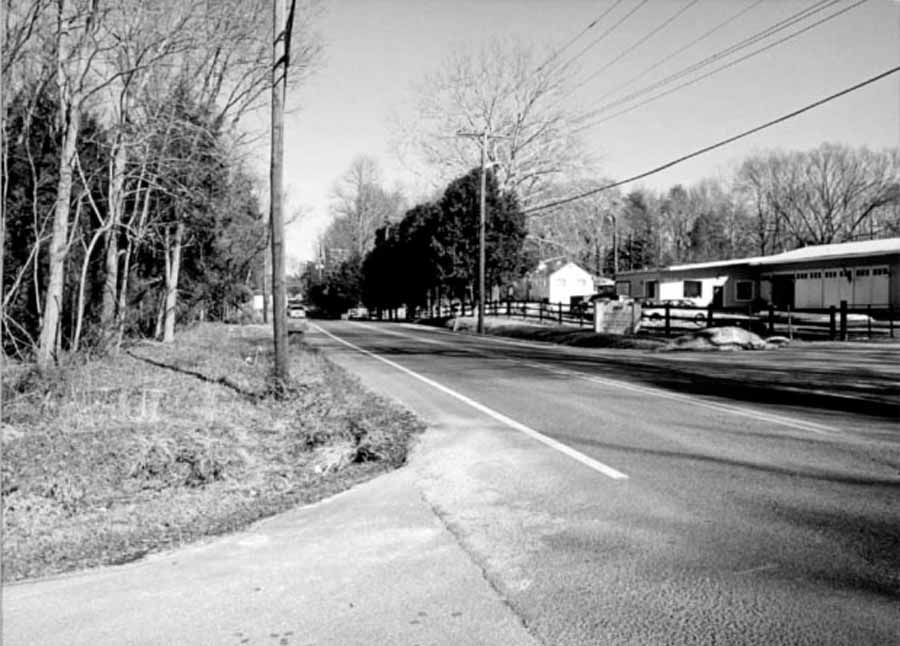
Photo credit:
MHT Files, n.d.
|
Broad Creek Historic District
Inventory No.:
PG:80-24
Other Name(s):
Aire
Date Listed:
12/8/2011
Location:
Fort Washington, Prince Georges County
Category:
District
Period/Date of Construction:
1662-1783
Resources:
25 (3 contributing, 22 non-contributing)
|
|
Description:
The Broad Creek Historic District includes approximately 455 acres situated in a semi-secluded designated rural tier area in southwestern Prince George's County, approximately three miles south of Washington, D.C. and nine miles from the U.S. Capitol. The district extends along both sides of Livingston Road east of the Potomac River and Broad Creek, a principal tributary, west of Indian Head Highway (MD 210), south of Old Fort Road/Oxon Hill Road, and north of Fort Washington Road. The Broad Creek Historic District derives its significance from a collection of 18th century buildings and landscape features that contribute to the areas of exploration and settlement and that represent 18th-century building forms, styles, and construction methods. The district includes three mid-18th-century buildings as well as the remnants of a canal that provide evidence of the prominent port town of Aire, established in 1706. The district stretches south from St. John's Church, erected c. 1766-1768 on the partial site of an older brick church constructed after the establishment of Piscataway Parish in 1692, and its associated cemetery. The remnants of a canal, completed by 1749, leading from Broad Creek and the ruins of Want Water, a 1 1/2-story, gambrel-roofed dwelling constructed in 1708, are situated adjacent to Broad Creek. The adjacent land includes Harmony Hall, a c. 1769 Georgian dwelling overlooking the Potomac River, just west of Livingston Road. A fourth 18th-century dwelling, Piscataway House, is situated near the center of the constructed c. 1750, was moved to the Broad Creek area from its original location in the village of Piscataway c. 1932 in order to avoid demolition.
|
Significance:
The Broad Creek Historic District is historically significant for its association with the colonial port town of Aire, established in 1706, and the site of Prince George's County's oldest church, St. John's Episcopal Church, established in 1692. The extant building on the site was constructed c. 1766-68. The subsequent development that occurred within Broad Creek was influenced by the establishment of the church in the late-17th century. The historic district is also architecturally significant as a notable collection of buildings that reflect distinct architectural styles, building plans, and construction types of the 18th century. The district boundary includes those properties historically associated with settlement with settlement of the Broad Creek, from 1662 through 1783, as well as interspersing areas of woodland that contribute to the cohesiveness and integrity of the 18th-century landscape setting.
|
|
District Resources
(25) (3 contributing, 22 non-contributing)
From associated listing in National Register nomination form. C = Contributing, NC = non-contributing, blank = not evaluated.
| Livingston Road | C | PG:80-10 -- Wantwater House (Lyles House) |
| 9801 Livingston Road | C | PG:80-7 -- St. John's Church (Broadcreek) |
| 10511 Livingston Road | C | PG:80-11 -- Harmony Hall (Battersea) |
| 9601 Livingston Road | NC | |
| 9611 Livingston Road | NC | |
| 9612 Livingston Road | NC | |
| 9700 Livingston Road | NC | |
| 9800 Livingston Road | NC | |
| 10101 Livingston Road | NC | |
| 10110 Livingston Road | NC | |
| 10114 Livingston Road | NC | |
| 10118 Livingston Road | NC | |
| 10211 Livingston Road | NC | |
| 10215 Livingston Road | NC | |
| 10300 Livingston Road | NC | |
| 10301 Livingston Road | NC | |
| 10307 Livingston Road | NC | PG:80-9 -- Piscataway House |
| 10310 Livingston Road | NC | |
| 10314 Livingston Road | NC | |
| 10315 Livingston Road | NC | |
| 10400 Livingston Road | NC | |
| 10406 Livingston Road | NC | |
| 10408 Livingston Road | NC | |
| Livingston Road (between Old Fort Road and MD 210) | NC | PG:80-24-43 -- Parcel 189 Vacant Lot |
| 10205 Livingstone Road | NC | |